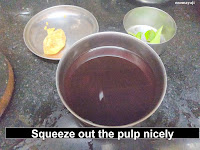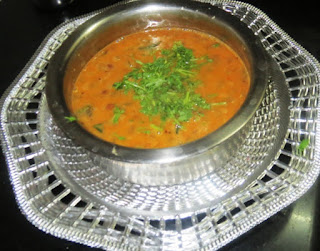Tambuli Or Tampina huli Does mean that this particular type of curry, helps to keep your body Cool. Tampu is a kannada word which means Cool. Eating this curry with rice in the first few spoons will definitely helps you to keep your body cool. You can have this with rice as I said in the beginning .
Spinach/Palak and little methi seeds (Fenugrik seeds) are used and prepared this Tabuli. (As we call it in Udupi (Dakshina Kannada).
Lets see some benefits of using Palak/Spinach in our diet.
Spinach/Palak is one of the wonderful green leafy vegetable and it is a store house of nutritions, anti oxidants and anti cancer properties. They are very low in calories and fats. The leaves contain good amount of soluble dietary fiber and control cholesterol levels in our body. Palak leaves are rich in vitamins like vitamin A, Viatmin C and beta carotene. Palak is good for normal eyesight. Spinach leaves are excellent source of vitamin K. Vitamin K helps to strengthen the bones. They contain good amounts of B- Complex vitamins and helps in preventing neural tube defects in the offspring. They contain good amount of Vitamin C and it helps the body to resists against infections. Palak/Spinach contain fair amount of minerals like potassium, manganese, magnesium, copper and zinc. they help in controlling heart beat and blood pressure. Copper helps in producing the red blood cells. Palak/Spinach contain good source of Omega - 3 fatty acids.
Use very little amount of coconut and do not fry or roast it. You can add curd later. Grind it with little water and add the required amount of curd/butter milk. Add water if required.
Lets see the recipe now:
Spinach : 1 bundle( medium size )
Jeera : 1/4 Tea spoon
Methi Seeds : 4 to 5
Pepper ( whole ) : 4 to 6 seeds.
Red Chilly : 1
Ingh : a pinch
To Grind :
Fried ingredients
Salt : to taste
Fresh coconut gratings : 1 Tablespoon
To Add :
Curd( yogurt) : 1/2 cup OR Buttermilk : 1 big glass
Water : If required
Seasoning : (Optional)
Ghee : 1 Tea spoon
Jeera : 1/2 Teaspoon
Ingh : a pinch
Curry leaves : 4 to 5
2. Keep a pan on the fire. Put ghee and Heat.
3. Add methi seeds and let it turn brown. Add jeera, pepper seeds and red chilly.
4. Fry this for 10 seconds. Add cut spinach and fry along with jeera mixture.
5. Fry for 10 to 20 seconds. Put off the fire. Add grated 1 tablespoon of fresh coconut. Add ingh.
6. Let fried mixture cool. Grind it with very little water. Remove it from the mixi jar.
7. Put it in a bowl. Add salt. Mix with a cup of curd.
8. You can also add ghee fried jeera and curry leaves seasoning to this Tambuli.
9. Add water if required. (Tambuli is served as first side dish and it is watery content since butter milk is used to dilute the content).
10. Serve with Hot rice.
Do not add more water while grinding ingredients. Add water if required, just before serving the dish. Add buttermilk instead of water. If adding curd dilute the curd/yogurt and then add it. This tambuli can be served as welcome drink. Dilute completely (by adding more water/butter milk and salt).
Adding jeera seasoning with ghee adds to the taste.
Time : 10 Minutes.
Serves : 3 to 4
(This is my one of the old post and I refreshed with pictures).
Spinach/Palak and little methi seeds (Fenugrik seeds) are used and prepared this Tabuli. (As we call it in Udupi (Dakshina Kannada).
Lets see some benefits of using Palak/Spinach in our diet.
Spinach/Palak is one of the wonderful green leafy vegetable and it is a store house of nutritions, anti oxidants and anti cancer properties. They are very low in calories and fats. The leaves contain good amount of soluble dietary fiber and control cholesterol levels in our body. Palak leaves are rich in vitamins like vitamin A, Viatmin C and beta carotene. Palak is good for normal eyesight. Spinach leaves are excellent source of vitamin K. Vitamin K helps to strengthen the bones. They contain good amounts of B- Complex vitamins and helps in preventing neural tube defects in the offspring. They contain good amount of Vitamin C and it helps the body to resists against infections. Palak/Spinach contain fair amount of minerals like potassium, manganese, magnesium, copper and zinc. they help in controlling heart beat and blood pressure. Copper helps in producing the red blood cells. Palak/Spinach contain good source of Omega - 3 fatty acids.
Use very little amount of coconut and do not fry or roast it. You can add curd later. Grind it with little water and add the required amount of curd/butter milk. Add water if required.
Lets see the recipe now:
Things Needed :
To Fry :Spinach : 1 bundle( medium size )
Jeera : 1/4 Tea spoon
Methi Seeds : 4 to 5
Pepper ( whole ) : 4 to 6 seeds.
Red Chilly : 1
Ingh : a pinch
To Grind :
Fried ingredients
Salt : to taste
Fresh coconut gratings : 1 Tablespoon
To Add :
Curd( yogurt) : 1/2 cup OR Buttermilk : 1 big glass
Water : If required
Seasoning : (Optional)
Ghee : 1 Tea spoon
Jeera : 1/2 Teaspoon
Ingh : a pinch
Curry leaves : 4 to 5
Method:
1. Wash Palak/Spinach leaves and let it dry nicely. Cut into small pieces.2. Keep a pan on the fire. Put ghee and Heat.
3. Add methi seeds and let it turn brown. Add jeera, pepper seeds and red chilly.
4. Fry this for 10 seconds. Add cut spinach and fry along with jeera mixture.
5. Fry for 10 to 20 seconds. Put off the fire. Add grated 1 tablespoon of fresh coconut. Add ingh.
6. Let fried mixture cool. Grind it with very little water. Remove it from the mixi jar.
7. Put it in a bowl. Add salt. Mix with a cup of curd.
8. You can also add ghee fried jeera and curry leaves seasoning to this Tambuli.
9. Add water if required. (Tambuli is served as first side dish and it is watery content since butter milk is used to dilute the content).
10. Serve with Hot rice.
Note :
Eating tambuli is a healthy habit and it cleanses our body. It reduce the cholesterol content of the food we eat.Do not add more water while grinding ingredients. Add water if required, just before serving the dish. Add buttermilk instead of water. If adding curd dilute the curd/yogurt and then add it. This tambuli can be served as welcome drink. Dilute completely (by adding more water/butter milk and salt).
Adding jeera seasoning with ghee adds to the taste.
Time : 10 Minutes.
Serves : 3 to 4
(This is my one of the old post and I refreshed with pictures).




































